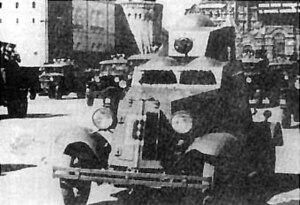FAI armoured car
This article needs additional citations for verification. (September 2014) |
| FAI armoured car | |
|---|---|
 | |
| Type | Armoured car |
| Place of origin | |
| Service history | |
| In service | 1933–41 |
| Used by | |
| Wars | Spanish Civil War Battles of Khalkhin Gol World War II |
| Production history | |
| Designer | Izhorskiy Zavod[1] |
| Designed | 1931–32[1] |
| Produced | 1933–35[1] |
| Specifications (FAI) | |
| Mass | 1.75 tonnes (1.93 short tons)[1] |
| Length | 3.69 m (12.1 ft)[1] |
| Width | 1.73 m (5.7 ft)[1] |
| Height | 2.07 m (6.8 ft)[1] |
| Crew | 2 |
| Armor | 4–6 mm |
Main armament | 7.62 mm DT machine gun (1512 rds.)[1] |
| Engine | GAZ-A L-head I4[1] 42 hp |
| Suspension | wheeled |
| Fuel capacity | 40 L[1] |
Operational range | 190–230 km (120–140 mi)[1] |
| Maximum speed | 83.1 km/h (51.6 mph)[1] |
The FAI (Ford-A Izhorskiy) armoured car was a replacement for the D-8 armoured car, used by the Soviet Union from the early 1930s to early 1940s.
Description[edit]
The FAI was built on the chassis of the GAZ-A car, a licensed copy of the American Ford A. This chassis was the major weakness of the FAI. Most commercial car chassis were not powerful enough to move a useful amount of armour or firepower on the battlefield. The Germans were known to get round this particular problem by designing a car chassis that was intended from the outset for both civilian and military vehicles and which was used successfully in at least one German armoured car family of this period. However, armoured cars based on commercial car chassis were, for the most part, road-bound, thinly armoured and lightly armed. The FAI was a typical example of this class of vehicle with a single 7.62 mm DT machine-gun in a revolving turret. The armour was sufficient to stop most shell fragments and small arms fire, but could not withstand any kind of cannon or heavy machine-gun fire. It was also very vulnerable to mines.
The FAI was built in relatively small numbers before being replaced by the very similar BA-20. The early BA-20 had the same vertically sided turret as the FAI. FAIs were employed in the early days of fighting on the Eastern Front in World War II.
The FAI and BA-20 series had a few advanced features. They were of all-welded construction in an era when very few AFVs were welded. Also, they had cork-filled tires to enable them to retain mobility even if the tires were penetrated.
The FAI and BA-20 are often mistaken for each other. The main recognition feature of the FAI is the two dome-shaped armoured covers over the driver and co-driver's stations. The BA-20 had a flat armoured roof in this area instead. Seen from the rear or side, the cabin of the FAI also only extends to just ahead of the rear axle centerline, leaving a significant flat shelf in the trunk area, where the spare wheel is mounted horizontally, while on the BA-20 the cabin extends further to the rear, with a much smaller shelf and the wheel is mounted vertically on the rear of the cabin.
Variants[edit]

- FAI (ФАИ, «Форд-А, Ижорский»). The FAI was built on the chassis of the GAZ-A car, a licensed copy of the US Ford A with 40 L fuel tank.[1]
- FAI-M (ФАИ-М, «ФАИ-Модернизированный») - upgraded variant, since 1938. The FAI-M was converted from the chassis of the newer GAZ-M1 car with 60 L fuel tank using spare upper hulls.[1]
- FAI-ZhD (ФАИ-жд, «ФАИ-железнодорожный») - From 1933 on, small numbers (only 9 were made) of FAI-ZhD were produced.[1][2] FAI-ZhD was a modification for additional railway usage. The speed on rails was 85 km/h forward and 24 km/h reverse. The road speed was 40 km/h. The changing of modes took the crew 30 minutes.
- GAZ-TK (ГАЗ-ТК, «ГАЗ-Трёхосный, Курчевского») - The armoured car was built on the chassis of the GAZ-AAA and equipped with 71-ТК radio. Only one prototype was made in 1934 - 1935.[1][3]
Users[edit]
- Red Army (1933–45)[1]
- Soviet Border Troops - 30 (1935–41)[1]
 Mongolian People's Republic - 15 (since 1936)[1]
Mongolian People's Republic - 15 (since 1936)[1] Second Spanish Republic - 20[1][4][5]
Second Spanish Republic - 20[1][4][5] Nazi Germany - The Germans used at least one captured FAI-M.[6]
Nazi Germany - The Germans used at least one captured FAI-M.[6]
References[edit]
- ^ a b c d e f g h i j k l m n o p q r s t Максим В. Коломиец. Броня на колёсах. История советского бронеавтомобиля 1925–1945 гг. М.: "Яуза", ООО "Стратегия КМ", "Эксмо", 2007. ISBN 978-5-699-21870-7
- ^ Kinnear, Jim (2000). Russian armoured cars, 1930-2000 (PDF). Darlington, Md.: Darlington Productions. ISBN 1-892848-05-8. Retrieved 14 January 2022.
- ^ инженер Е. Прочко. Бронированные разведчики // журнал "Техника молодежи", № 3, 1983. стр.28-29
- ^ Рыбалкин, Ю. (2000), Операция "Х": Советская помощь республиканской Испании (1936–1939) [Operation "X": Soviet aid to Republican Spain (1936-1939)] (in Russian), pp. 43–45
- ^ "VEHÍCULOS BLINDADOS" [Armored vehicles]. Fuerzas Armadas de la República (in Spanish).
- ^ Oswald, Werner (2003), Полный каталог военных автомобилей и танков Германии, 1900–1982гг. [Full catalog of military vehicles and tanks of Germany, 1900-1982] (in Russian), ACT/Астрель, p. 335, ISBN 978-5-271-04875-3
Sources[edit]
- М. В. Коломиец. Лёгкие бронеавтомобили Красной Армии довоенной постройки ("Фронтовая иллюстрация" № 2 2007). – М.: ООО "Стратегия КМ", 2007.
External links[edit]
- FAI Archived 2012-04-25 at the Wayback Machine at Battlefield.ru
- U.S. WWII Newsmap, "Russian Armored Vehicles", hosted by the UNT Libraries Digital Collections
